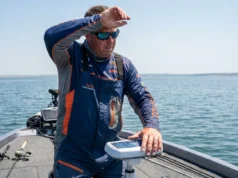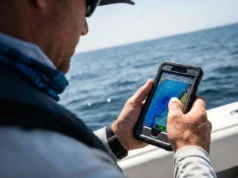In this article
A heavy boot hits the grassy bank of a quiet farm pond. To you, it is just a step. To the water, it is a seismic event. A pressure wave travels through the soil and into the water column significantly faster than sound moves through the air.
Long before your lure splashes down, the lateral line of a largemouth bass has processed that vibration as a threat. The bite in the shallows shuts down instantly.
To master small water angling, you must abandon the “cast and hope” mentality of the casual weekender. Success in pond fishing is not about luck; it is a rigorous application of physics, biology, and engineering.
Over decades of pond hopping—from manicured urban ponds to overgrown farm ponds—I have learned that the angler who treats a body of water like a laboratory always out-fishes the one who treats it like a slot machine. Success demands a fundamental shift: you must learn to read the invisible thermal layers, manage your acoustic footprint, and condense your arsenal into a mobile system that strikes with surgical precision.
What defines the unique hydrodynamics of a small impoundment?
Small waters behave differently than large reservoirs primarily due to their limited volume and lack of wind fetch. Because the wind cannot build up enough energy to mix the water naturally, local ponds are subject to rigid temperature layering that dictates exactly where fish populations can and cannot survive.
How does thermal stratification dictate the habitable zones for fish?
In the heat of summer, a pond is not a uniform bowl of water; it is a layer cake of distinct thermal zones. Because small ponds lack the wave action required to mix these layers, they stratify heavily. You have the warm surface layer (Epilimnion), the transition layer (Metalimnion or Thermocline), and the cold bottom layer (Hypolimnion).
While the bottom layer is cooler, it often becomes anoxic—meaning it holds zero oxygen—during mid-summer. This creates a phenomenon I call the “Squashing Effect.” The rising anoxic zone from the bottom and the super-heated water at the surface compress the water column into a narrow band, often just 6 to 8 feet deep.
If you are dredging a deep crankbait across the bottom of the basin in July, you are fishing in a biological graveyard. You must adjust your depth control, learning to read the thermocline to locate the strike zone where water temperature and oxygen intersect.
However, this rigid structure breaks down during spring and fall “turnover.” As air temperatures drop, the surface water cools, becomes denser, and sinks, mixing with the bottom layers. You can identify this by a sudden murky appearance or a sulfurous, rotten-egg smell. This natural mixing process temporarily disrupts fishing patterns, scattering fish throughout the water column until stability returns.
Why do inlets and outlets create high-percentage ambush points?
Inlets are the life support systems of small ponds. Whether it is a feeder creek, a culvert, or a drainage pipe, these areas inject oxygen and regulate temperature, creating “micro-climates” distinct from the main basin. Turbulent water entering a pond increases dissolved oxygen levels, which helps attract baitfish and the predators that hunt them, especially during the dog days of summer.
In many small city ponds, look for fountains or aerators. While artificial, the water movement creates the same oxygenated draw as a natural inlet.
Beyond oxygen, moving water carries silt. Over time, sediment deltas form at inlet mouths, creating shallow flats that support benthic invertebrates. Predators patrol these flats to feed. Understanding how to approach these zones involves mastering current breaks and eddies near inflow points, allowing you to drift a bait naturally into the waiting mouth of a bass.
Pro-Tip: Watch for the “mud line” after a rain event. This is the distinct border where dirty runoff meets clear pond water. Bass use this visual barrier as a curtain, hiding in the murky water to ambush prey passing in the clear water. Cast parallel to this line for high-percentage strikes.
Conversely, keep an eye on outlets and spillways. These act as “pinch points” where current concentrates prey items being washed out of the system. While sedimentation controls can alter the topography, the biological draw of moving water remains constant.
Why is stealth the apex skill for the bank angler?
In a jon boat or canoe, you are a floating object disconnected from the fish’s environment. On the bank, you are physically coupled to their world. In pressured public ponds, your presence—shadow, silhouette, and vibration—is the single biggest limiting factor to your success.
How does the physics of ground transmission compromise your approach?
Sound travels effectively from solid ground into water due to acoustic coupling. This means the thud of a boot is amplified underwater. Fish possess a sensory organ called the lateral line system, which detects low-frequency vibrations (1–80 Hz) and pressure gradients.
Heavy footsteps vibration triggers this defense mechanism long before you make visual contact, causing bass to lock their jaws or retreat to deep cover. To counter this, adopt the “Stingray Shuffle” or a soft-walking technique. Avoid “stomping” or jumping off steep banks. Your goal is to minimize the energy transfer from your body weight into the soil.
Visual stealth is equally critical. Approaching the water standing tall creates a “skylining” effect, where your dark silhouette contrasts sharply against the bright sky. This is easily detected by fish looking upward. You must lower your profile—crouching or kneeling—to blend with the background vegetation. This concept is rooted in understanding how fish vision and light refraction function, giving you the upper hand before the first cast is made.
Wear drab clothing and utilize polarized sunglasses to spot cruising fish without casting shadows over the target area.
Pro-Tip: Stop 10 to 15 feet back from the water’s edge to make your first few casts. The “pressure wave” of your arrival often pushes fish slightly off the bank. Catch the active ones from a distance before walking up to the shoreline.
How do you engineer a mobile gear system for micro-fisheries?
Pond fishing is a “run-and-gun” discipline. You cannot anchor and wait; you must move to find active fish. This requires a gear system that prioritizes versatility and weight reduction over the specialized, heavy arsenals used by boat anglers.
What is the “One Rod” solution for covering the water column?
Carrying four rods through heavy brush is a recipe for frustration and broken tips. The ideal pond rod is a 7’0″ Medium-Heavy power, Fast action spinning rod. This configuration offers the perfect balance. It has enough backbone to drive single hooks on a Texas rig or jig, yet retains enough tip flex to cast weightless plastics effectively.
When choosing the correct rod power and action, versatility is the metric that matters most. Modern multi-piece travel rods are excellent for this, utilizing V-joint technology to eliminate dead spots, making them indistinguishable from one-piece rods but far easier to transport.
Pair this with a 2500–3000 size reel. The critical variable, however, is your fishing line. A 15-20lb braided line main line provides zero stretch and cuts through vegetation like weed lines and lily pads. Always utilize a 6-8 foot fluorocarbon leader (8-12lb test).
This combination provides the necessary abrasion resistance and invisibility near the lure, as detailed in guides on fishing line properties. This “One Rod” system allows you to switch from topwater to finesse bottom fishing by simply changing the lure, not the rod.
How should lure selection adapt to seasonal trophic dynamics?
You cannot simply guess; you must “match the hatch” based on the pond’s specific biological cycles. Lure selection is not about what looks good on the shelf, but what aligns with the metabolic needs of the predator.
- Pre-Spawn (Spring): Bass need high calories for egg production. Target the crawfish molt using red lipless crankbaits or jigs.
- Spawn (Late Spring): Focus on nest raiders. Lures mimicking bluegill or pumpkinseed sunfish (green pumpkin/chartreuse) trigger aggression in guarding bass. This requires decoding the pre-spawn to post-spawn phases to know exactly when to switch tactics.
- Summer: The “Frog Bite” dominates. Use hollow body frogs over weed mats or punch through vegetation to reach the oxygenated shade.
- Fall: Bait fish migrate to the backs of creeks. Use “reaction baits” like spinnerbaits and squarebill crankbaits to mimic shad.
Seasonal Forage & Lure Match
Optimize your fishing strategy by aligning lure choice and speed with seasonal water temperatures.
Primary Forage
Winter-kill Shad
Best Lure
Blade Bait / Spoon
Presentation Speed
Dead Slow (Vertical)
Key Location
Deep Dam Basin
Primary Forage
Crawfish (Molting)
Best Lure
Red Lipless Crank
Presentation Speed
Moderate / Stop-Go
Key Location
Points / Flats
Primary Forage
Bluegill / Salamanders
Best Lure
Lizard / Creature
Presentation Speed
Stationary / Twitch
Key Location
Shallow Pockets
Primary Forage
Bluegill / Shad
Best Lure
Deep Crank / Worm
Presentation Speed
Fast (Reaction) or Slow (Drop)
Key Location
Thermocline / Shade
Primary Forage
Baitfish / Frogs
Best Lure
Spinnerbait / Topwater
Presentation Speed
Fast / Burn
Key Location
Shallow Banks
Understanding forage fish dynamics allows you to predict where bass will be. In late summer, don’t ignore the terrestrial insect hatch. Hoppers and beetles falling from overhanging trees become a major food source. Utilizing the “drip line” under these trees can be deadly.
Final Thoughts
Pond mastery is not granted; it is earned through observation. It comes from understanding that Thermal Stratification dictates where fish live, and that stealth is a physics problem you must solve with every step.
By adopting a consolidated mobile gear system and applying Trophic Matching to your lure selection, you stop fishing for luck and start hunting with purpose. Explore our library of species-specific guides to refine your approach further, or share your most effective “pond hopping” tactic in the comments below.
Frequently Asked Questions about Pond Fishing
What is the best all-around bait for pond fishing?
For artificial lures, a 5-inch Senko (stick bait) rigged weightless or as a wacky rig is universally effective due to its subtle, natural action. For live bait, a simple nightcrawler under a slip bobber remains the most reliable method for catching a variety of species including largemouth bass, bluegill, and channel catfish.
How can you tell where the deep spots are in a pond without sonar?
Observe the bank angle; a steep shoreline usually continues steeply underwater, while a flat, marshy bank indicates shallow flats. The pond dam face is typically the deepest part of any man-made pond, with the depth decreasing as you move toward the inlet or creek mouth. Google Earth scouting beforehand can also reveal drop-offs by looking for color changes in the water.
Why do fish stop biting in the middle of summer?
High water temperatures and low oxygen levels (hypoxia) often force fish into a lethargic state, reducing their feeding windows to dawn and dusk. Thermal stratification may create a dead zone at the bottom, meaning anglers fishing deep are placing lures in water that fish cannot survive in.
Do I need a long rod for bank fishing?
No, a shorter rod (6’6 to 7’0) is often better for bank fishing as it is easier to maneuver around overhanging trees and brush. Accuracy is more valuable than distance in pond fishing; a shorter rod improves casting precision into tight pockets of cover.
Risk Disclaimer: Fishing, boating, and all related outdoor activities involve inherent risks that can lead to injury. The information provided on Master Fishing Mag is for educational and informational purposes only. While we strive for accuracy, the information, techniques, and advice on gear and safety are not a substitute for your own best judgment, local knowledge, and adherence to official regulations. Fishing regulations, including seasons, size limits, and species restrictions, change frequently and vary by location. Always consult the latest official regulations from your local fish and wildlife agency before heading out. Proper handling of hooks, knives, and other sharp equipment is essential for safety. Furthermore, be aware of local fish consumption advisories. By using this website, you agree that you are solely responsible for your own safety and for complying with all applicable laws. Any reliance you place on our content is strictly at your own risk. Master Fishing Mag and its authors will not be held liable for any injury, damage, or loss sustained in connection with the use of the information herein.
Affiliate Disclosure: We are a participant in the Amazon Services LLC Associates Program, an affiliate advertising program designed to provide a means for us to earn advertising fees by advertising and linking to Amazon.com. As an Amazon Associate, we earn from qualifying purchases. We also participate in other affiliate programs and may receive a commission on products purchased through our links, at no extra cost to you. Additional terms are found in the terms of service.





